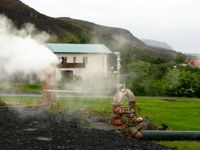Friday, April 19, 2024
News and Views from the Global South
ENVIRONMENT: Earth Can Generate Summer out of Winter
Lowana Veal* - IPS/IFEJ
- Iceland manages to produce tomatoes, paprika and cucumbers all year round by harnessing geothermal energy locally, even though the growing season is short.
Now there are six geothermal power plants in the country. Three of these, the tiny Bjarnaflag and the larger Nesjavellir and Svartsengi plants, provide hot water for district heating as well as electricity. The Reykjanes, Krafla and Hellisheidi plants are used solely for producing electricity.
All of these power stations lie in high-temperature geothermal fields, where the water emerges as steam at 200 degrees Celsius, but is so full of minerals and gases that it cannot directly be used for heating purposes. Instead, it is used to heat cold water that can then be used for space heating. However, water from high-temperature areas is ideal for producing electricity.
Low-temperature geothermal areas produce steam at a temperature that does not exceed 150 degrees C. This can be used directly for district heating. One such area lies in Mosfellsdalur, on the outskirts of Reykjavik, and is tapped for space heating for the Reykjavik area.
But geothermal energy is also utilised on a smaller scale. The Blue Lagoon, which uses wastewater from the adjacent Svartsengi geothermal plant to heat its mineral-rich waters, is one of Iceland's top tourist attractions that is also used for treating psoriasis sufferers. A similar development was opened in North Iceland a few years ago, using water from a borehole from the Bjarnarflag geothermal station.
Many agricultural communities have developed their own little geothermal systems for local use, while in some cases individuals or private enterprises have tapped geothermal heat directly from the earth.
Fludir, a small agricultural village in South Iceland that is located in a low- temperature geothermal zone, is one such. Hannibal Kjartansson from Hitaveita Fluda (HF), the local district heating utility, told IPS: "The utility was started in 1964 by a group of farmers who wanted to heat their greenhouses. Today, about half of the hot water sold goes to greenhouses."
HF have an experimental borehole from which they hope to generate electricity as well as hot water, but the project is still very much in the experimental stage.
The bigger companies in Fludir, such as the Fludasveppir mushroom company, the Fludafiskur fish processing company and the greenhouses Jorfi and Melar get their heat directly form HF, but some farmers have developed their own systems, sometimes in collaboration with a neighbour.
Fludasveppir uses geothermal heat as part of their mushroom production process. Georg Ottosson explains the cycle. "Fresh root mass is put into cubicles on a weekly basis, then after six weeks, when all the mushrooms have been picked, the cubicles are heated with hot water to 80 degrees to sterilise the cubicles. The mushrooms are cultivated in rooms which mimic the seasons, so the temperature can be anywhere between 16 degrees and 25 degrees, although 18 degrees is the norm."
The fish processing company Fludafiskur exports dried fish and fish heads to Nigeria, and uses hot water to heat the air used in the fish-drying process. "The air is heated to 20 degrees and is then blown onto the fish, which are placed on racks in special cubicles. The process takes four to seven days, depending on the size of the fish," says Margret Gunnarsdottir from the company.
Dairy farmer Sigurdur Sigurjonsson has his own borehole, operated in conjunction with two neighbouring dairy farms. When asked why he developed the borehole, he said: "At that time (1984), the house, cowshed and stables were heated with electricity as HS was not connecting people who lived as far out as we do. As we knew that hot water was present, we decided to utilise it."
Sixty kilometres away, at the horticultural department of the Agricultural University of Iceland in Hveragerdi, bananas and other tropical produce are grown in an experimental greenhouse heated by geothermal energy. "We have our own heating system, which we use for heating the school buildings, showers and greenhouses," says Gudridur Helgadottir, head of the Vocational Training and Continuing Education Department.
Gudni Thorvaldsson also works at the Agricultural University, though in a different location. He is just starting a project mostly financed by Reykjavik Energy on the use of hot water to heat golf courses and football fields.
"The idea is to lengthen the time that these can be used, by heating the soil in the latter half of winter and into spring. Because the heating system is very expensive, it is important to do a trial on a small plot before going on to bigger projects. This experiment is designed to find out when it is safe to start heating the soil and how much the soil should be heated," he says. Half of the trial will be with grass used on football fields and half on grass used on golf courses.
(*This story is part of a series of features on sustainable development by IPS – Inter Press Service, and IFEJ – the International Federation of Environmental Journalists.)

 Print
Print




